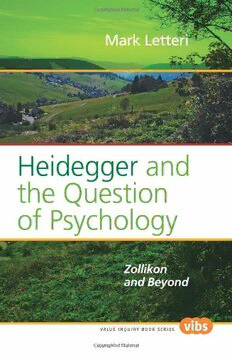Table Of ContentHeidegger and tHe
Question of PsycHology
Zollikon and Beyond
VIBS
Volume 200
robert ginsberg
Founding Editor
leonidas donskis
Executive Editor
Associate Editors
g. John M. abbarno steven V. Hicks
george allan richard t. Hull
gerhold K. Becker Michael Krausz
raymond angelo Belliotti Mark letteri
Kenneth a. Bryson Vincent l. luizzi
c. stephen Byrum adrianne Mcevoy
Harvey cormier alan Milchman
Robert A. Delfino Peter a. redpath
rem B. edwards alan rosenberg
Malcolm d. evans arleen l. f. salles
daniel B. gallagher John r. shook
andrew fitz-gibbon eddy souffrant
francesc forn i argimon tuija takala
William gay emil Višňˇovský
dane r. gordon anne Waters
J. everet green John r. Welch
Heta aleksandra gylling thomas Woods
Matti Häyry
a volume in
Philosophy and Psychology
PAP
Mark letteri, editor
Heidegger and tHe
Question of PsycHology
Zollikon and Beyond
Mark letteri
amsterdam - new york, ny 2009
cover photo: dr.jur. Hans g. Müsse: View from Heidegger’s vacation
chalet in todtnauberg. Heidegger wrote most of Being and Time there.
cover design: studio Pollmann
the paper on which this book is printed meets the requirements of “iso
9706:1994, information and documentation - Paper for documents -
requirements for permanence”.
isBn: 978-90-420-2522-6
©editions rodopi B.V., amsterdam - new york, ny 2009
Printed in the netherlands
To JoAnne and Marie, the twin lights of my life
CONTENTS
Guest Foreword ix
Emmy van Deurzen
Preface xiii
Acknowledgments xv
INTRODUCTION 1
Part One
Being in the World
ONE Da-sein: Opening Thoughts 13
1. Being T/here 13
2. World and Finding 17
3. Time and Temporality 25
TWO Da-sein: Integral Realities 33
1.Consciousness 33
2.The Unconscious 34
3.Action 40
4.Being-with 42
5. Bodying Forth 46
Part Two
Ways of Being
THREE Da-sein as Possibility 55
1. Being Called and Falling 55
2. Being Claimed, Authenticity, and 61
Inauthenticity
3. Openness at the Limit 70
FOUR Further Connections
1. Experience and Meaning 79
2. Leaping Ahead with Da-sein 84
viii HEIDEGGER AND THE QUESTION OF PSYCHOLOGY
CONCLUSION 91
Works Cited 95
About the Author 101
Index 103
GUEST FOREWORD
Existential therapy is a search for truth. The dialogue with the client is a dis-
cussion in which we aim to elucidate and reveal life in as many guises as pos-
sible. Heidegger has contributed a tremendous amount to such explorations.
His work is a much underrated resource that enables therapists and psycholo-
gists to work more deliberately and in a much more broadly based and wide
ranging manner. The practice of psychotherapy and psychology as inspired by
Heidegger’s work is about opening up our view of the world, which is nor-
mally so closed and confined. It is about asking new ontological questions,
rather than remaining based in the ontic troubles that restrain a person’s being
in the world. It is about getting back to fundamental truths in a person’s exis-
tence so that she can build her life firmly on solid foundations.
Few psychologists and psychotherapists have gone through the trouble of
studying Heidegger in any detail, in spite of the recent flourishing of the exis-
tential therapies (Cooper 2003, Cohn 2002, Deurzen 1997, Deurzen and Ar-
nold-Baker 2005). Heidegger was one of the most important philosophers of
the last century and he worked closely with Medard Boss (2001) in applying
his ideas to the practice of psychiatry and psychology. These developments
have left us with a wealth of guidelines on how to apply philosophy to psycho-
therapy and how to refocus a person’s confusion by addressing those things
that really matter to him.
Amongst other things Heidegger proposed that we should comprehend
the far reaching consequences of the human being’s (Dasein’s) necessary and
continuing engagement with both truthful and untruthful ways of being.
Dasein will always belong to its world and to some extent to other people and
because of this will inevitably live in a disowned way for much of the time.
Because of this Heidegger’s ideas are more centered on the worldhood of
Dasein and less on its internal world. He suggests that Dasein is inauthentic for
most of the time, that is, taken over by the world of others, and that even when
we master an authentic, owned way of being, we will inevitably return to inau-
thenticity again. Forgetfulness is often just a consequence of Dasein’s absorp-
tion in its world and in others (Deurzen 2003). The anonymous “They” will
continue to exert power over Dasein inexorably. Dasein’s problem is how to
be strong enough to stand up to the world in which it is embedded. To wrest
itself out of its engagement with the world in order to attain a position of tran-
scendence is a continuous challenge. Dasein can certainly achieve such tran-
scendence momentarily in the moment of vision and with anticipatory reso-
luteness, but this is by no means an achievement that can be taken for granted.
In spite of Heidegger’s reservations about the existence of a self, he
shows how Dasein’s fundamental mineness leads to its aspiration to realize its
ownmost potentiality for being-itself. This mineness makes Dasein affirm its

